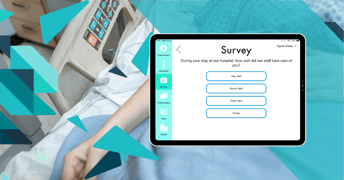Using Patient Feedback to Improve Service Levels
7 minute read | 22/10/2021

When thinking logically about improving a service, it makes sense to survey the people receiving it, figure out what's missing from their perspective and fix it. It's no different in healthcare. In hospitals and other facilities, patient feedback is pivotal to creating long-lasting, impactful change the end-user will notice and value.
According to the British Medical Journal (BMJ), patient feedback is: "The recording of the patient's perspective on the quality of care received for the purpose of learning how to improve processes and the patient experience."
So, how can facilities best achieve this outcome? What types of feedback are most effective to get us one step closer to a positive patient experience? And what should providers be aware of when collecting and actioning feedback in the future?
Different Types of Patient Feedback
There are many ways to canvas patient feedback and collect patient thoughts throughout their care.
Verbal Feedback
The first and perhaps most obvious option is through conversation, gaining verbal insight into the patient experience. This can be done one-on-one in a patient-doctor consultation or through a more organised event like a focus group.
While this can yield interesting insights through inflexion, tone of voice and expressions, verbal feedback is prone to bias. People may attempt to say what they think others want them to or, in a group setting, be influenced by other individuals in the conversation.
Follow-Up Feedback
Following up after a health service is thought to provide the most balanced opinion of a service as the user has had time to reflect and has no reason to fear the consequences of giving negative feedback. People in this scenario often give more reasoned explanations and candid descriptions of care.
Telephone, email and even SMS interviews can help determine this data. However, the respondents and those who consent to the process will often be the most engaged patients. This might mean your sample isn't always representative of the entire patient population.
Written Feedback
Letters and comment cards are given to receive written feedback collected and analysed at a facility's leisure. As opposed to follow-up feedback and verbal sessions, this method has the advantage of not requiring an operator or another member of staff to be present. As medical staff are often pushed for time, this can become an appealing option.
However, the uptake of written feedback forms is low. Patients might struggle to see the value in a less interactive way to word their thoughts, or they may be worried about making grammatical errors or spelling mistakes, especially if English isn't their first language.
Digital Rating Scales
The advantages of both interactive and more autonomous feedback are drawn together with digital rating scales. Similarly, the drawbacks of bias, sample quality and uptake are dismissed by providing a way to give feedback digitally.
Hospitals are beginning to see the incredible outcome of using digital means to canvas opinion, using things like internet forms to offer a quick, accessible and anonymous form of feedback. The SPARK TSL patient engagement platform provides this opportunity for individual facilities that want to track in-depth analytics, while the NHS feedback portal is available to any patient nationally.
Find out more about patient feedback and the role is has to play in improving patient experience by download our guide.
|
As a provider that helps hospitals and other healthcare facilities to improve the patient experience, we always practice what we preach. That's why we have our own SPARK TSL suggestion box to allow all of our users to leave constructive, anonymous feedback so we can make the most relevant changes to our interface. Leave your suggestion below: |
Why Collect Patient Feedback?
We know collecting patient feedback can improve service levels, but what does this really mean? More specifically, patient feedback helps:
- Monitor performance of a healthcare facility across different divisions to help improve customer service, as well as more stringent practices like remaining compliant with specific health regulations.
- Assess improvement impact to see if implemented changes have the intended effect. In doing so, this creates accountability throughout the improvement process and provides an opportunity to tweak low-performing initiatives and generate case studies out of successful ones.
- Enhance team understanding of the patient's experience, giving them quantitative and qualitative feedback around patient perception, their greatest challenges and ideal outcomes.
- Improve patient education through better understanding the effectiveness of engagement strategies and the barriers to engagement, ultimately improving the patient experience and reducing readmission rates.
- Showing organisational accountability and willingness to improve to the outside world, delivering the message that you're a proactive healthcare provider with the right intentions towards outcomes.
- Including patients in hospital improvement strategies and making those at the centre of the service feel empowered by redefining healthcare to be, first and foremost, about the patient experience.
- Provide comparison to other healthcare providers and hospitals, as well as attempt to standardise service across a multi-site organisation.
Patient Feedback Challenges and Limitations
It can be hard to get healthcare feedback correct, even though there are many advantages and avenues to collect it.
Healthcare providers need to strike the right balance between getting enough respondents to form a representative sample by offering feedback in the most convenient format and receiving the right feedback quality by waiting for patients to reflect on their experience and give reasoned answers.
As with any form of feedback, there's a risk of receiving overly negative feedback when patients are in a heightened state. However, leaving collecting feedback to the last minute or even after the event reduces the potential number of people giving feedback at any one time.
Medical staff don't want to use exaggerated feedback to make too radical changes, yet they still want to take some form of action and canvas opinion when they can. What's more, to many medical staff, collecting feedback can feel like another low-priority task on a neverending to-do list. Depending on staff involvement in feedback, being actively engaged in improvement processes can put unnecessary pressure on hospital staff when demand for their service is high. Even though, ironically, this is when facilities need to find out more about the patient experience the most.
Finally, removing bias from the feedback process is almost impossible when it isn't collated digitally by a third-party platform. Sampling bias can be present when healthcare professionals only pick patients they know will be willing to participate or have a positive view of their care. Additionally, inconvenient forms of feedback or formats with barriers for some patients will mean a small percentage of the hospital population will contribute to feedback forums.
The many challenges and obstacles to obtaining unbiased and actionable feedback are no secret. These problems have been assessed in many academic studies and addressed in a framework created by Nursing Times. According to this guidance, healthcare providers and hospitals must:
- Show a willingness to address an issue (normative legacy).
- Provide the necessary autonomy, ownership of the problem and resources to be able to act (structural legitimacy).
- Be ready and able to support change (organisational readiness).
The idea behind this framework is similar to the director for improving patient experience, NHS England, NeilChurchill's's belief that: "The importance of feedback is not what we collect but what we do with it."
Despite this, the format of feedback and its rollout to patients is fundamental in maintaining quality control. In turn, hospitals are better positioned to make positive changes to satisfy all patients and improve the patient experience.
Adopting Digital Forms of Feedback to Start Improving Service Levels
Before organisations can think of reviewing their improvement processes and how they handle feedback, they first must start at the basics — refining the collection of feedback. Digital feedback yields more actionable insights that everyone receiving a health service can benefit from. This is because digital feedback encourages a diverse group of recipients and is completely anonymised, allowing patients to give wholly honest advice.
Digital feedback also overcomes the time obstacle of collecting feedback, allowing patients to fill out forms when they feel fit without any staff involvement. In turn, feedback feels more thought out, less reactive and lends itself to more long-lasting change.
Feedback is essential in our patient engagement platform too.
Improve the Patient Experience by Using Our Latest Features
Not only can SPARK TSL provide a way to enhance patient engagement through a multi-functional interface on any device and house a place for digital feedback to take place, but it also has a whole range of new features introduced after our latest update.
We used feedback from our users to find new and even more innovative ways to improve patient experiences. Click the button below to find out about all of our new and exciting updates.
About the author
Rebecca O'Donovan
Becky is the Marketing Director at SPARK TSL, of whom she has worked for since 2012. She is responsible for high-level marketing strategy focusing on lead generation and aiding the vision of the business to ensure business growth.
More articles by the author
Related articles
 Healthcare Industry
Healthcare Industry
How Patient Feedback Can Drive Improvement in the NHS | SPARK TSL
In all industries, feedback is a great tool to use to target areas that need improving. Honest feedback is ...
 Healthcare Industry
Healthcare Industry
How to Improve Patient Engagement in Their Own Healthcare | SPARK TSL
With a surge in telehealth and virtual care, the pandemic has prompted people to engage with their own care ...
 Patient Experience
Patient Experience
How SPARK Fusion Surveys Help NHS Teams Listen & Improve
Welcome to Matchmaking March! Each week, we tackle a different NHS challenge and pair it with a feature from ...




